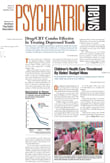In 2002, Avshalom Caspi, Ph.D., of the Institute of Psychiatry in London and colleagues reported in the journal Science that a particular version of a gene plays a role in anti-social behavior. The gene in question was the monoamine oxidase A gene (MAO-A gene), located on the X chromosome. This gene helps people digest food containing amine groups such as serotonin and inactivates neurotransmitters such as dopamine.
Specifically, Caspi and his coworkers found that maltreated boys who had a particular variant of the MAO-A gene that produces low MAO-A activity were more likely to develop antisocial problems than were maltreated boys who had a version of the MAO-A gene that produces high MAO-A activity. In other words, it looked as though possessing the MAO-A gene version that leads to low MAO-A activity might interact with an adverse childhood to produce antisocial behavior.
The above finding has now been replicated by a group of researchers at Virginia Commonwealth University. The lead investigator was Debra Foley, Ph.D., an assistant professor of human genetics at Virginia Commonwealth University. Results appeared in the July Archives of General Psychiatry.
“This is an important replication of the findings reported by Caspi et al. from this center in 2002 of an interaction between a variant in the MAO-A gene and early adversity in the causation of antisocial behavior,” Peter McGuffin, M.D., director of the Social, Genetic, and Developmental Psychiatry Center of the Institute of Psychiatry in London, told Psychiatric News. “The fact that Foley et al. used a different methodology (for example, they used a simpler and retrospective measure of early adversity) and were studying a younger sample of subjects but still found the same pattern as Caspi and colleagues suggests that the finding is robust.”
The MAO-A gene, in fact, appears to be the first gene strongly linked with either conduct disorder or antisocial behavior, Foley indicated to Psychiatric News. Or at least, she said, there are “none with major effects that has been independently replicated that I know of.”
The study included 514 white male twins from the community-based, longitudinal Virginia Twin Study for Adolescent Behavioral Development. The twins were 8 to 17 years old. Twins and their parents were interviewed at home by trained field workers at several different time points to learn whether the twins were exhibiting signs of conduct disorder and/or were being brought up in an adverse environment—that is, one of inconsistent discipline, parental neglect, or interparental violence. DNA samples were also taken from the twins at two different time points for analysis to see whether the twins contained a version of the MAO-A gene that produces low MAO-A activity in the body.
The researchers found that among the twins participating in the study, the prevalence of conduct disorder was 11 percent, the prevalence of a low-activity MAO-A gene was 29 percent, the prevalence of exposure to inconsistent parental discipline was 17 percent, the prevalence of exposure to parental neglect was 13 percent, and the prevalence of exposure to interparental violence was 3 percent.
The investigators found that inconsistent parental discipline, parental neglect, and exposure to interparental violence were independent risk factors for conduct disorder, but a low-activity MAO-A gene was not. However, a low-activity MAO-A gene was determined to be a risk factor for conduct disorder when combined with an adverse childhood environment.
The findings suggest “a relatively robust effect of MAO-A in combination with exposure to environmental adversity on risk for conduct disorder,” Foley and her team concluded in their study report. The results, they pointed out, “are also consistent with reports from adoption studies describing an increased risk for antisocial behavior in boys in association with an interaction between aggregate genetic effects and exposure to adversities within the adoptive family.”
And finally, the scientists reported, their findings are “a rare example of a measured gene and a measured environment jointly affecting human behavior.”
The study was funded by the National Institute of Mental Health, the Carman Trust for Scientific Research, and a MacArthur Junior Faculty Award.
Arch Gen Psychiatry 2004 61 738
